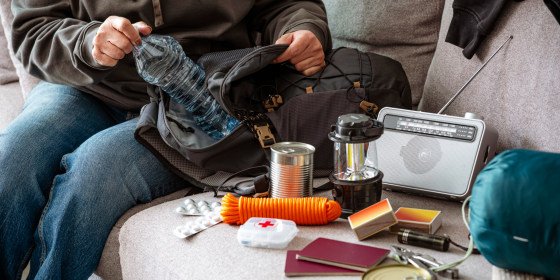$165.00
Redfora

This three-day emergency kit includes a variety of agency-recommended items like a hand-crank radio, first-aid kit and multiple water pouches, plus some additional nice-to-haves, like water purification tablets, nylon rope, a sewing kit, a candle and hand warmers. The supplies are labeled and color-coated in bags that have a QR code that you can scan to find out more about how to use them, according to the brand. Everything comes in a red backpack, and the two-person version (linked above) weighs about 18 pounds.
You can read a full list of the included supplies on Redfora’s website. This emergency kit doesn’t have all of the recommended shelter and communication supplies mentioned above, so you may want to supplement it with things like plastic sheeting, batteries, charging tools and local maps.
This emergency kit has fewer supplies than our top pick but costs significantly less. It’s a good starting point to build a larger kit, and it’s small enough to fit into a larger emergency pack. Highlights include twelve 4.2 ounces water pouches, two 12-hour emergency lightsticks and two survival blankets. You can read a full list of the included supplies on Ready America’s website.
A one-person emergency kit is great for individuals or as a small backup option to keep in places like cars, boats or your place of work. This one-person kit is lightweight at just under five pounds, and comes in a blue backpack that has a mesh outer pocket that’s a good fit for stuffing things like clothes or blankets. Inside, it has key supplies like water pouches, a first-aid kit, and a crank-powered flashlight. (You can read the full list of included supplies on Blue Coolers’ website.)
It’s always a good idea to supplement a pre-built survival kit with other tools and supplies specific to your environment and needs. Or you might want to build a personalized go-bag from scratch. Either way, we selected highly rated first aid, hygiene, light source, shelter, communication and protection supplies fit for any emergency kit.
A first-aid kit should include a variety of supplies for treating wounds and injuries. You should add personal items like medications and emergency contacts, and check the kit regularly for expired items, according to the American Red Cross. You should not only have a first aid kit at home, but in places like your car.
FEMA recommends a three-day supply of nonperishable food and water in any disaster kit. Water in particular can be tricky — while it is easy to store, it is heavy to carry with you in the case of an evacuation. Below are a few top-rated water storage and water filtration supplies that may fit your needs.
Whistles can get incredibly loud with a lot less effort on your part than shouting or yelling. If you’re in distress and need help, blow a whistle three times — three of anything in a repeating sequence is known to be an international sign of distress (SOS), according to the Utah Department of Public Safety.
A flashlight is critical if your power is out and you need to get around safely in the dark.
Most flashlights (and some radios) are powered by disposable AA or AAA batteries, and Ready.gov recommends storing a few extras in your emergency kit. Portable chargers and backup power stations can also be useful in case of a blackout.
A radio is a good way to get updates on the disaster, including any known safety risks, according to FEMA.
Maintaining your body temperature in hot or cold weather is vital for survival, according to the Utah Department of Public Safety. A sleeping bag can help you stay warm in cold conditions and you can typically roll it into a smaller size so it can easily fit into an emergency bag. You can learn more in our sleeping bags guide.
The American Red Cross recommends putting N95 or surgical masks in your emergency kit, depending on the types of disasters common to your area.
If you don’t have access to running clean water or soap, you can use moist towelettes and hand wipes to clean and sanitize.
The right tools and shelter can make it easier to shut off damaged household utilities (in case of downed wires, for example), open canned food and shelter in place.
Ready.gov recommends any basic disaster supply kit have maps of your area. You can buy local maps online or print out maps at home using tools like the U.S. Geological Survey national map viewer.
If you don’t have a GPS device, a manual compass is also essential for map navigation.
The American Red Cross recommends packing a cell phone, personal documents like medication lists, proof of address, passports, extra cash and more. What this looks like in practice depends on your household and needs. Either way, it can be useful to store said documents in a fireproof document bag. Here’s what else to know about storing your documents safely.
I’m a reporter at NBC Select who covers technology and fitness including recent stories on air purifiers, wireless earbuds, and walking shoes. For this piece, I researched emergency preparation guidelines from reputable agencies like FEMA, the CDC and the American Red Cross.
Catch up on NBC Select’s in-depth coverage of tech and tools, wellness and more, and follow us on Facebook, Instagram, Twitter and TikTok to stay up to date.